Finance Project: Financial Planning, Risk, and Investment Analysis
VerifiedAdded on 2020/06/05
|12
|2429
|25
Project
AI Summary
This finance project delves into various aspects of personal finance, starting with an analysis of a Lifetime ISA, exploring its benefits and maximum contribution limits. It then calculates the maximum loan amount Mark and Spencer can borrow based on their affordability. The project further assesses the value of an annuity and savings over a three-year period. It then examines the advantages and disadvantages of interest-only mortgages. The assignment then addresses potential risks Mark and Spencer may face and explores the difference between real and nominal values, calculating both for a house and mortgage. The project analyzes short-term and long-term assets and liabilities, calculates net worth, gearing, and current asset ratios, and provides interpretations of the financial performance. Part B of the project discusses risks associated with retirement and suggests strategies for financial security, including the importance of savings, investment in various funds, and the potential of annuity products. The project concludes by highlighting various ways retirees can mitigate risks, such as through part-time work, investment in insurance, and adapting to inflation.

Finance Project
Paraphrase This Document
Need a fresh take? Get an instant paraphrase of this document with our AI Paraphraser
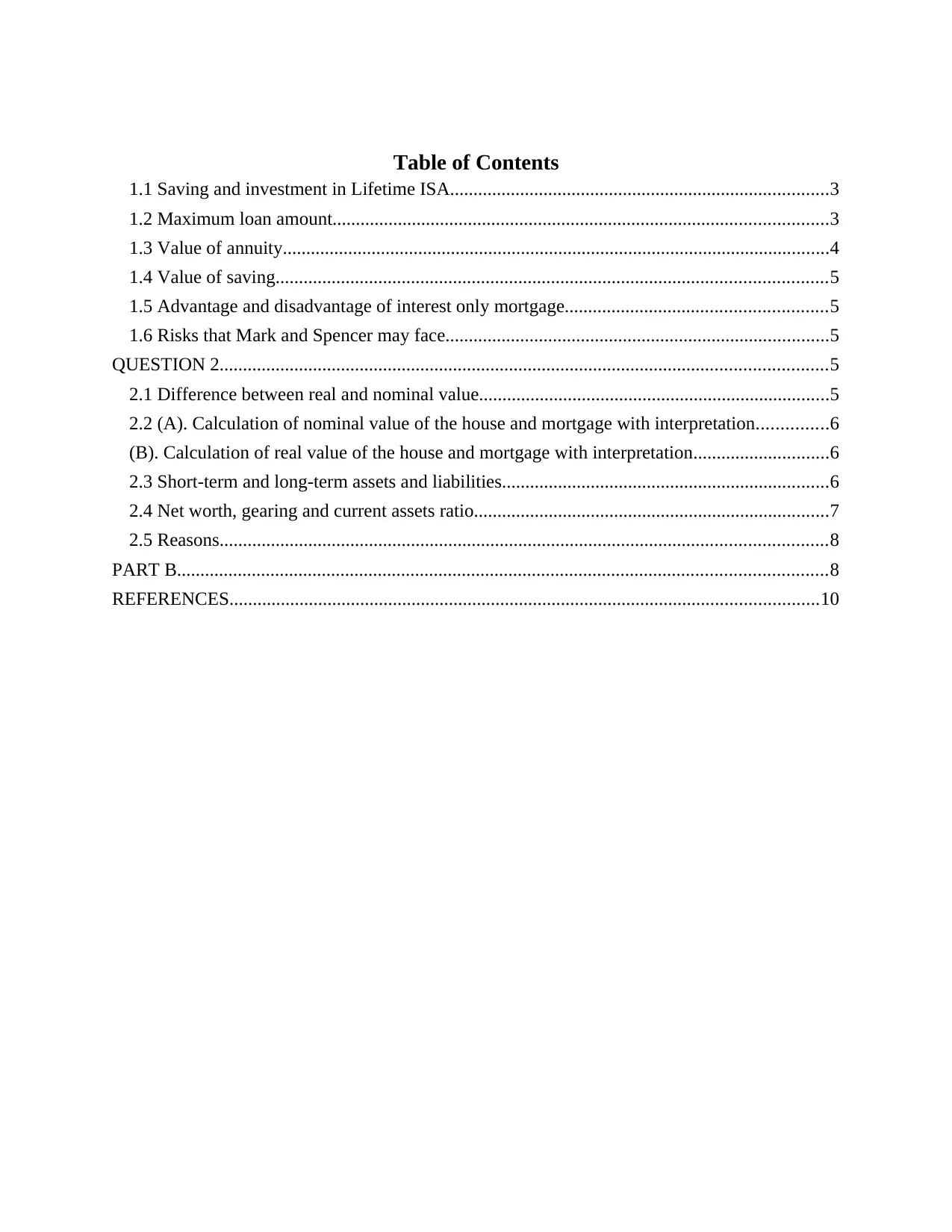
Table of Contents
1.1 Saving and investment in Lifetime ISA.................................................................................3
1.2 Maximum loan amount..........................................................................................................3
1.3 Value of annuity.....................................................................................................................4
1.4 Value of saving......................................................................................................................5
1.5 Advantage and disadvantage of interest only mortgage........................................................5
1.6 Risks that Mark and Spencer may face..................................................................................5
QUESTION 2..................................................................................................................................5
2.1 Difference between real and nominal value...........................................................................5
2.2 (A). Calculation of nominal value of the house and mortgage with interpretation...............6
(B). Calculation of real value of the house and mortgage with interpretation.............................6
2.3 Short-term and long-term assets and liabilities......................................................................6
2.4 Net worth, gearing and current assets ratio............................................................................7
2.5 Reasons..................................................................................................................................8
PART B...........................................................................................................................................8
REFERENCES..............................................................................................................................10
1.1 Saving and investment in Lifetime ISA.................................................................................3
1.2 Maximum loan amount..........................................................................................................3
1.3 Value of annuity.....................................................................................................................4
1.4 Value of saving......................................................................................................................5
1.5 Advantage and disadvantage of interest only mortgage........................................................5
1.6 Risks that Mark and Spencer may face..................................................................................5
QUESTION 2..................................................................................................................................5
2.1 Difference between real and nominal value...........................................................................5
2.2 (A). Calculation of nominal value of the house and mortgage with interpretation...............6
(B). Calculation of real value of the house and mortgage with interpretation.............................6
2.3 Short-term and long-term assets and liabilities......................................................................6
2.4 Net worth, gearing and current assets ratio............................................................................7
2.5 Reasons..................................................................................................................................8
PART B...........................................................................................................................................8
REFERENCES..............................................................................................................................10

1.1 Saving and investment in Lifetime ISA
(Source: New Lifetime ISA, 2016)
New Individual Savings Account, known as Lifetime ISA aims to help people to save
long-term life. Government adds a bonus & in this, savings can be withdrawn without penalty
after the age of 60 years to support retirement or buy a first home. In this fund, Mark can
contribute with maximum limit of £4000 per annum and at the end of the tax year, government
adds a bonus which grow fund. Savings of the fund comprises tax-free interest, 25% bonus and
investment growth which Mark may use to purchase their first home (New Lifetime ISA, 2016).
At the time of retirement, all the remaining amount of savings can be withdraw without any tax
when Mark crosses the age of 60 years. Thus, the plan will be definitely so helpful for the Mark
being a first-time buyer.
1.2 Maximum loan amount
While raising money through loan to purchase a new home, Mark and Spencer will need
to satisfy the loan conditions. Before granting loan, bank investigates the affordability of
customer to judge that whether he or she can afford to make payment of the loan obligations
timely or not. Affordability test is performed to examine the income and its relevant essential
(Source: New Lifetime ISA, 2016)
New Individual Savings Account, known as Lifetime ISA aims to help people to save
long-term life. Government adds a bonus & in this, savings can be withdrawn without penalty
after the age of 60 years to support retirement or buy a first home. In this fund, Mark can
contribute with maximum limit of £4000 per annum and at the end of the tax year, government
adds a bonus which grow fund. Savings of the fund comprises tax-free interest, 25% bonus and
investment growth which Mark may use to purchase their first home (New Lifetime ISA, 2016).
At the time of retirement, all the remaining amount of savings can be withdraw without any tax
when Mark crosses the age of 60 years. Thus, the plan will be definitely so helpful for the Mark
being a first-time buyer.
1.2 Maximum loan amount
While raising money through loan to purchase a new home, Mark and Spencer will need
to satisfy the loan conditions. Before granting loan, bank investigates the affordability of
customer to judge that whether he or she can afford to make payment of the loan obligations
timely or not. Affordability test is performed to examine the income and its relevant essential
⊘ This is a preview!⊘
Do you want full access?
Subscribe today to unlock all pages.

Trusted by 1+ million students worldwide
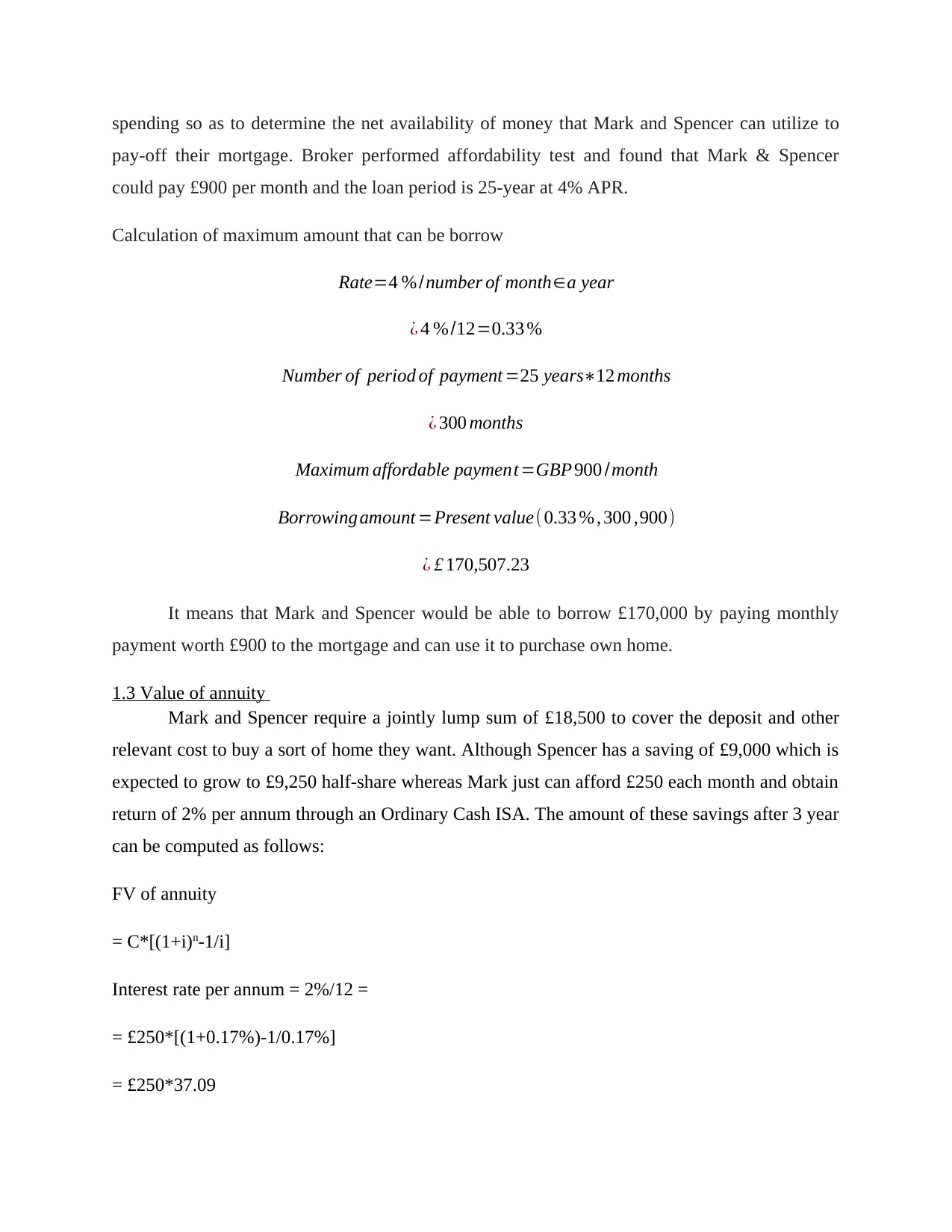
spending so as to determine the net availability of money that Mark and Spencer can utilize to
pay-off their mortgage. Broker performed affordability test and found that Mark & Spencer
could pay £900 per month and the loan period is 25-year at 4% APR.
Calculation of maximum amount that can be borrow
Rate=4 % /number of month∈a year
¿ 4 % /12=0.33 %
Number of period of payment =25 years∗12 months
¿ 300 months
Maximum affordable payment=GBP 900 /month
Borrowing amount =Present value( 0.33 % , 300 ,900)
¿ £ 170,507.23
It means that Mark and Spencer would be able to borrow £170,000 by paying monthly
payment worth £900 to the mortgage and can use it to purchase own home.
1.3 Value of annuity
Mark and Spencer require a jointly lump sum of £18,500 to cover the deposit and other
relevant cost to buy a sort of home they want. Although Spencer has a saving of £9,000 which is
expected to grow to £9,250 half-share whereas Mark just can afford £250 each month and obtain
return of 2% per annum through an Ordinary Cash ISA. The amount of these savings after 3 year
can be computed as follows:
FV of annuity
= C*[(1+i)n-1/i]
Interest rate per annum = 2%/12 =
= £250*[(1+0.17%)-1/0.17%]
= £250*37.09
pay-off their mortgage. Broker performed affordability test and found that Mark & Spencer
could pay £900 per month and the loan period is 25-year at 4% APR.
Calculation of maximum amount that can be borrow
Rate=4 % /number of month∈a year
¿ 4 % /12=0.33 %
Number of period of payment =25 years∗12 months
¿ 300 months
Maximum affordable payment=GBP 900 /month
Borrowing amount =Present value( 0.33 % , 300 ,900)
¿ £ 170,507.23
It means that Mark and Spencer would be able to borrow £170,000 by paying monthly
payment worth £900 to the mortgage and can use it to purchase own home.
1.3 Value of annuity
Mark and Spencer require a jointly lump sum of £18,500 to cover the deposit and other
relevant cost to buy a sort of home they want. Although Spencer has a saving of £9,000 which is
expected to grow to £9,250 half-share whereas Mark just can afford £250 each month and obtain
return of 2% per annum through an Ordinary Cash ISA. The amount of these savings after 3 year
can be computed as follows:
FV of annuity
= C*[(1+i)n-1/i]
Interest rate per annum = 2%/12 =
= £250*[(1+0.17%)-1/0.17%]
= £250*37.09
Paraphrase This Document
Need a fresh take? Get an instant paraphrase of this document with our AI Paraphraser
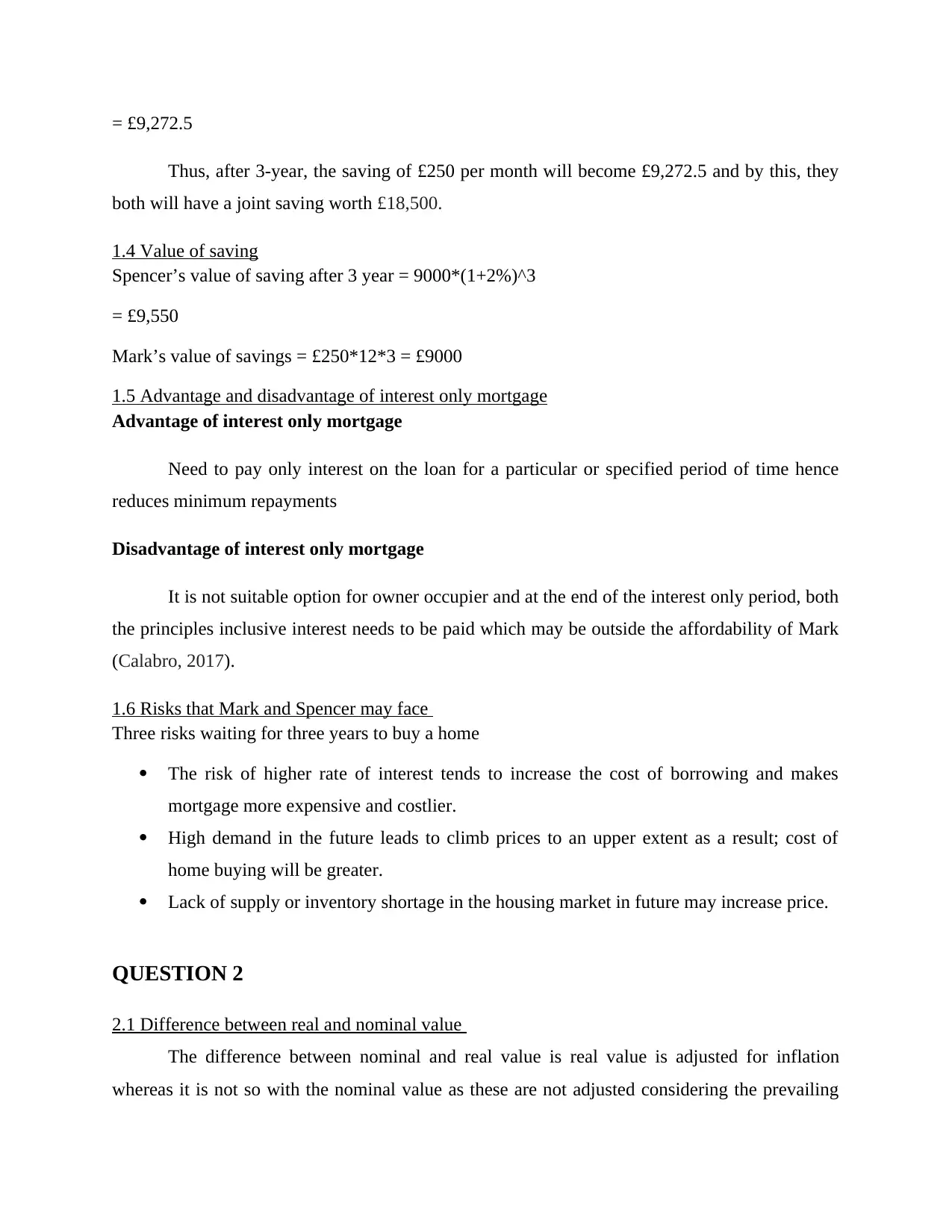
= £9,272.5
Thus, after 3-year, the saving of £250 per month will become £9,272.5 and by this, they
both will have a joint saving worth £18,500.
1.4 Value of saving
Spencer’s value of saving after 3 year = 9000*(1+2%)^3
= £9,550
Mark’s value of savings = £250*12*3 = £9000
1.5 Advantage and disadvantage of interest only mortgage
Advantage of interest only mortgage
Need to pay only interest on the loan for a particular or specified period of time hence
reduces minimum repayments
Disadvantage of interest only mortgage
It is not suitable option for owner occupier and at the end of the interest only period, both
the principles inclusive interest needs to be paid which may be outside the affordability of Mark
(Calabro, 2017).
1.6 Risks that Mark and Spencer may face
Three risks waiting for three years to buy a home
The risk of higher rate of interest tends to increase the cost of borrowing and makes
mortgage more expensive and costlier.
High demand in the future leads to climb prices to an upper extent as a result; cost of
home buying will be greater.
Lack of supply or inventory shortage in the housing market in future may increase price.
QUESTION 2
2.1 Difference between real and nominal value
The difference between nominal and real value is real value is adjusted for inflation
whereas it is not so with the nominal value as these are not adjusted considering the prevailing
Thus, after 3-year, the saving of £250 per month will become £9,272.5 and by this, they
both will have a joint saving worth £18,500.
1.4 Value of saving
Spencer’s value of saving after 3 year = 9000*(1+2%)^3
= £9,550
Mark’s value of savings = £250*12*3 = £9000
1.5 Advantage and disadvantage of interest only mortgage
Advantage of interest only mortgage
Need to pay only interest on the loan for a particular or specified period of time hence
reduces minimum repayments
Disadvantage of interest only mortgage
It is not suitable option for owner occupier and at the end of the interest only period, both
the principles inclusive interest needs to be paid which may be outside the affordability of Mark
(Calabro, 2017).
1.6 Risks that Mark and Spencer may face
Three risks waiting for three years to buy a home
The risk of higher rate of interest tends to increase the cost of borrowing and makes
mortgage more expensive and costlier.
High demand in the future leads to climb prices to an upper extent as a result; cost of
home buying will be greater.
Lack of supply or inventory shortage in the housing market in future may increase price.
QUESTION 2
2.1 Difference between real and nominal value
The difference between nominal and real value is real value is adjusted for inflation
whereas it is not so with the nominal value as these are not adjusted considering the prevailing
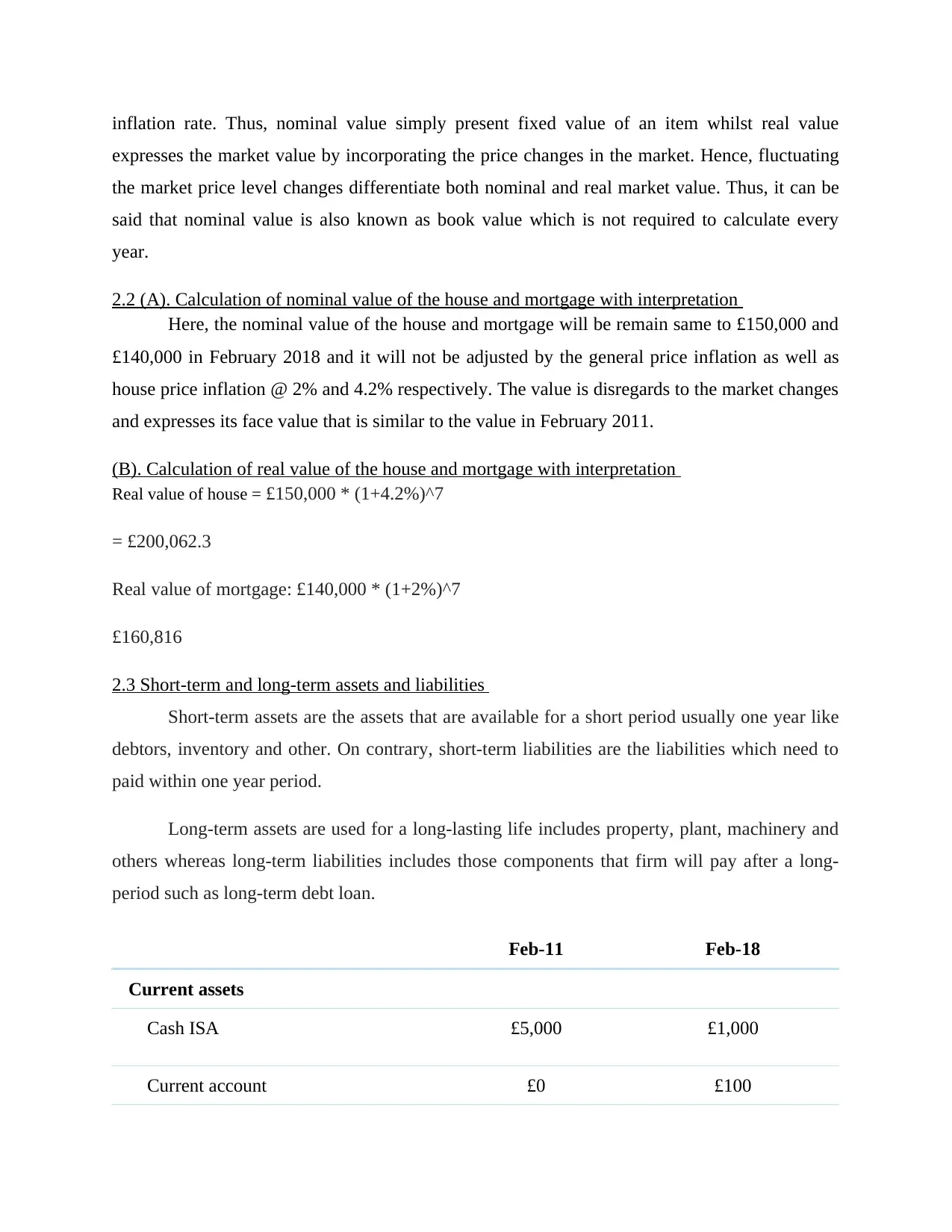
inflation rate. Thus, nominal value simply present fixed value of an item whilst real value
expresses the market value by incorporating the price changes in the market. Hence, fluctuating
the market price level changes differentiate both nominal and real market value. Thus, it can be
said that nominal value is also known as book value which is not required to calculate every
year.
2.2 (A). Calculation of nominal value of the house and mortgage with interpretation
Here, the nominal value of the house and mortgage will be remain same to £150,000 and
£140,000 in February 2018 and it will not be adjusted by the general price inflation as well as
house price inflation @ 2% and 4.2% respectively. The value is disregards to the market changes
and expresses its face value that is similar to the value in February 2011.
(B). Calculation of real value of the house and mortgage with interpretation
Real value of house = £150,000 * (1+4.2%)^7
= £200,062.3
Real value of mortgage: £140,000 * (1+2%)^7
£160,816
2.3 Short-term and long-term assets and liabilities
Short-term assets are the assets that are available for a short period usually one year like
debtors, inventory and other. On contrary, short-term liabilities are the liabilities which need to
paid within one year period.
Long-term assets are used for a long-lasting life includes property, plant, machinery and
others whereas long-term liabilities includes those components that firm will pay after a long-
period such as long-term debt loan.
Feb-11 Feb-18
Current assets
Cash ISA £5,000 £1,000
Current account £0 £100
expresses the market value by incorporating the price changes in the market. Hence, fluctuating
the market price level changes differentiate both nominal and real market value. Thus, it can be
said that nominal value is also known as book value which is not required to calculate every
year.
2.2 (A). Calculation of nominal value of the house and mortgage with interpretation
Here, the nominal value of the house and mortgage will be remain same to £150,000 and
£140,000 in February 2018 and it will not be adjusted by the general price inflation as well as
house price inflation @ 2% and 4.2% respectively. The value is disregards to the market changes
and expresses its face value that is similar to the value in February 2011.
(B). Calculation of real value of the house and mortgage with interpretation
Real value of house = £150,000 * (1+4.2%)^7
= £200,062.3
Real value of mortgage: £140,000 * (1+2%)^7
£160,816
2.3 Short-term and long-term assets and liabilities
Short-term assets are the assets that are available for a short period usually one year like
debtors, inventory and other. On contrary, short-term liabilities are the liabilities which need to
paid within one year period.
Long-term assets are used for a long-lasting life includes property, plant, machinery and
others whereas long-term liabilities includes those components that firm will pay after a long-
period such as long-term debt loan.
Feb-11 Feb-18
Current assets
Cash ISA £5,000 £1,000
Current account £0 £100
⊘ This is a preview!⊘
Do you want full access?
Subscribe today to unlock all pages.

Trusted by 1+ million students worldwide
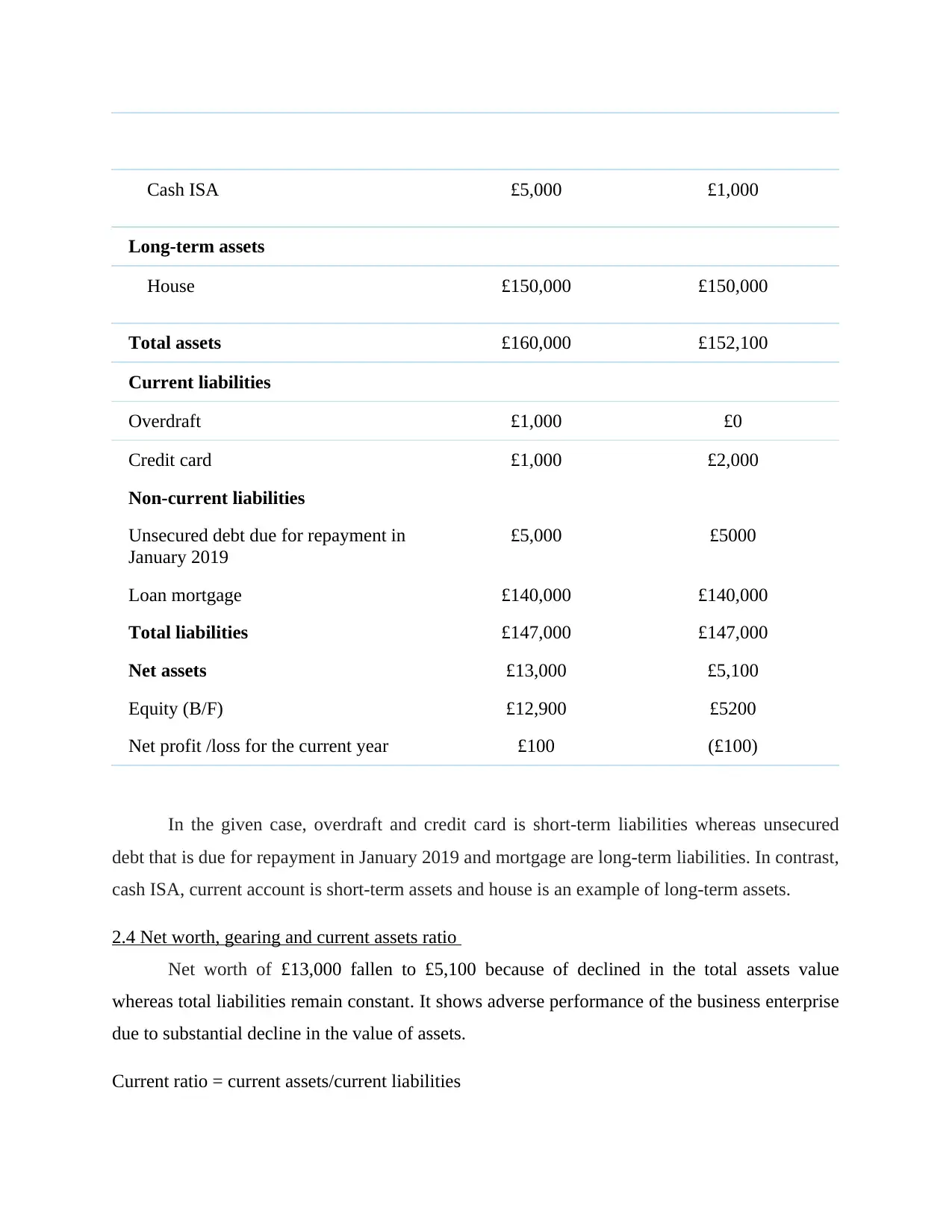
Cash ISA £5,000 £1,000
Long-term assets
House £150,000 £150,000
Total assets £160,000 £152,100
Current liabilities
Overdraft £1,000 £0
Credit card £1,000 £2,000
Non-current liabilities
Unsecured debt due for repayment in
January 2019
£5,000 £5000
Loan mortgage £140,000 £140,000
Total liabilities £147,000 £147,000
Net assets £13,000 £5,100
Equity (B/F) £12,900 £5200
Net profit /loss for the current year £100 (£100)
In the given case, overdraft and credit card is short-term liabilities whereas unsecured
debt that is due for repayment in January 2019 and mortgage are long-term liabilities. In contrast,
cash ISA, current account is short-term assets and house is an example of long-term assets.
2.4 Net worth, gearing and current assets ratio
Net worth of £13,000 fallen to £5,100 because of declined in the total assets value
whereas total liabilities remain constant. It shows adverse performance of the business enterprise
due to substantial decline in the value of assets.
Current ratio = current assets/current liabilities
Long-term assets
House £150,000 £150,000
Total assets £160,000 £152,100
Current liabilities
Overdraft £1,000 £0
Credit card £1,000 £2,000
Non-current liabilities
Unsecured debt due for repayment in
January 2019
£5,000 £5000
Loan mortgage £140,000 £140,000
Total liabilities £147,000 £147,000
Net assets £13,000 £5,100
Equity (B/F) £12,900 £5200
Net profit /loss for the current year £100 (£100)
In the given case, overdraft and credit card is short-term liabilities whereas unsecured
debt that is due for repayment in January 2019 and mortgage are long-term liabilities. In contrast,
cash ISA, current account is short-term assets and house is an example of long-term assets.
2.4 Net worth, gearing and current assets ratio
Net worth of £13,000 fallen to £5,100 because of declined in the total assets value
whereas total liabilities remain constant. It shows adverse performance of the business enterprise
due to substantial decline in the value of assets.
Current ratio = current assets/current liabilities
Paraphrase This Document
Need a fresh take? Get an instant paraphrase of this document with our AI Paraphraser
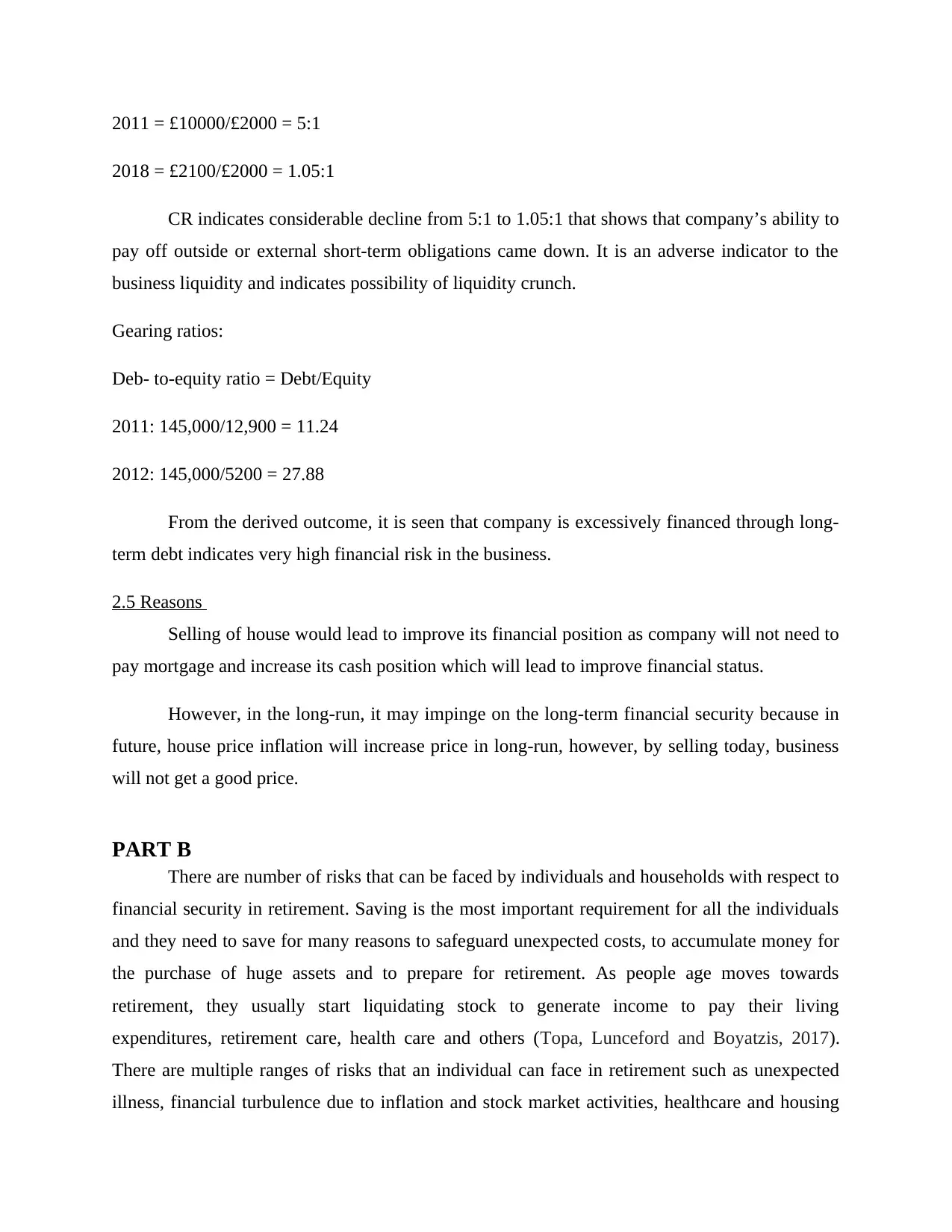
2011 = £10000/£2000 = 5:1
2018 = £2100/£2000 = 1.05:1
CR indicates considerable decline from 5:1 to 1.05:1 that shows that company’s ability to
pay off outside or external short-term obligations came down. It is an adverse indicator to the
business liquidity and indicates possibility of liquidity crunch.
Gearing ratios:
Deb- to-equity ratio = Debt/Equity
2011: 145,000/12,900 = 11.24
2012: 145,000/5200 = 27.88
From the derived outcome, it is seen that company is excessively financed through long-
term debt indicates very high financial risk in the business.
2.5 Reasons
Selling of house would lead to improve its financial position as company will not need to
pay mortgage and increase its cash position which will lead to improve financial status.
However, in the long-run, it may impinge on the long-term financial security because in
future, house price inflation will increase price in long-run, however, by selling today, business
will not get a good price.
PART B
There are number of risks that can be faced by individuals and households with respect to
financial security in retirement. Saving is the most important requirement for all the individuals
and they need to save for many reasons to safeguard unexpected costs, to accumulate money for
the purchase of huge assets and to prepare for retirement. As people age moves towards
retirement, they usually start liquidating stock to generate income to pay their living
expenditures, retirement care, health care and others (Topa, Lunceford and Boyatzis, 2017).
There are multiple ranges of risks that an individual can face in retirement such as unexpected
illness, financial turbulence due to inflation and stock market activities, healthcare and housing
2018 = £2100/£2000 = 1.05:1
CR indicates considerable decline from 5:1 to 1.05:1 that shows that company’s ability to
pay off outside or external short-term obligations came down. It is an adverse indicator to the
business liquidity and indicates possibility of liquidity crunch.
Gearing ratios:
Deb- to-equity ratio = Debt/Equity
2011: 145,000/12,900 = 11.24
2012: 145,000/5200 = 27.88
From the derived outcome, it is seen that company is excessively financed through long-
term debt indicates very high financial risk in the business.
2.5 Reasons
Selling of house would lead to improve its financial position as company will not need to
pay mortgage and increase its cash position which will lead to improve financial status.
However, in the long-run, it may impinge on the long-term financial security because in
future, house price inflation will increase price in long-run, however, by selling today, business
will not get a good price.
PART B
There are number of risks that can be faced by individuals and households with respect to
financial security in retirement. Saving is the most important requirement for all the individuals
and they need to save for many reasons to safeguard unexpected costs, to accumulate money for
the purchase of huge assets and to prepare for retirement. As people age moves towards
retirement, they usually start liquidating stock to generate income to pay their living
expenditures, retirement care, health care and others (Topa, Lunceford and Boyatzis, 2017).
There are multiple ranges of risks that an individual can face in retirement such as unexpected
illness, financial turbulence due to inflation and stock market activities, healthcare and housing
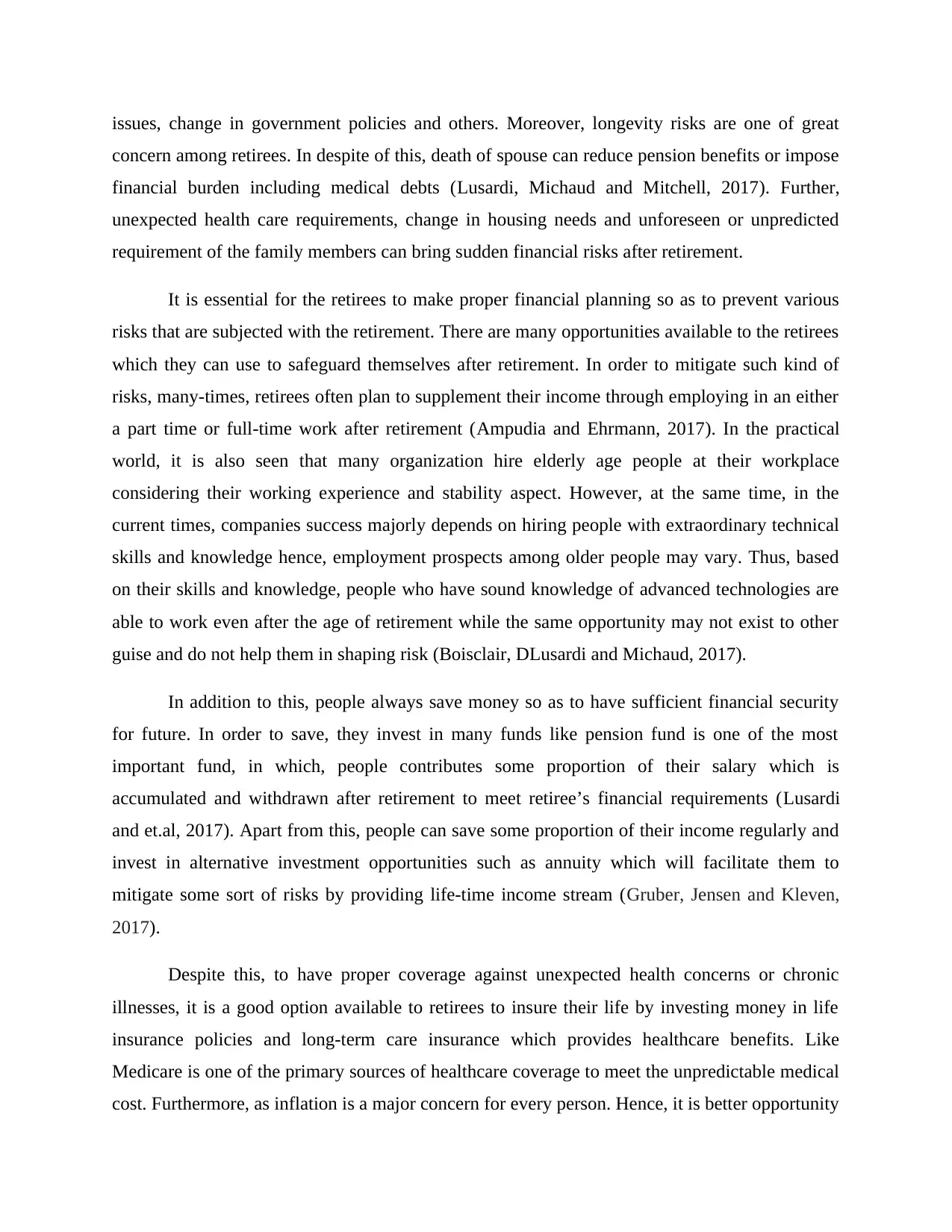
issues, change in government policies and others. Moreover, longevity risks are one of great
concern among retirees. In despite of this, death of spouse can reduce pension benefits or impose
financial burden including medical debts (Lusardi, Michaud and Mitchell, 2017). Further,
unexpected health care requirements, change in housing needs and unforeseen or unpredicted
requirement of the family members can bring sudden financial risks after retirement.
It is essential for the retirees to make proper financial planning so as to prevent various
risks that are subjected with the retirement. There are many opportunities available to the retirees
which they can use to safeguard themselves after retirement. In order to mitigate such kind of
risks, many-times, retirees often plan to supplement their income through employing in an either
a part time or full-time work after retirement (Ampudia and Ehrmann, 2017). In the practical
world, it is also seen that many organization hire elderly age people at their workplace
considering their working experience and stability aspect. However, at the same time, in the
current times, companies success majorly depends on hiring people with extraordinary technical
skills and knowledge hence, employment prospects among older people may vary. Thus, based
on their skills and knowledge, people who have sound knowledge of advanced technologies are
able to work even after the age of retirement while the same opportunity may not exist to other
guise and do not help them in shaping risk (Boisclair, DLusardi and Michaud, 2017).
In addition to this, people always save money so as to have sufficient financial security
for future. In order to save, they invest in many funds like pension fund is one of the most
important fund, in which, people contributes some proportion of their salary which is
accumulated and withdrawn after retirement to meet retiree’s financial requirements (Lusardi
and et.al, 2017). Apart from this, people can save some proportion of their income regularly and
invest in alternative investment opportunities such as annuity which will facilitate them to
mitigate some sort of risks by providing life-time income stream (Gruber, Jensen and Kleven,
2017).
Despite this, to have proper coverage against unexpected health concerns or chronic
illnesses, it is a good option available to retirees to insure their life by investing money in life
insurance policies and long-term care insurance which provides healthcare benefits. Like
Medicare is one of the primary sources of healthcare coverage to meet the unpredictable medical
cost. Furthermore, as inflation is a major concern for every person. Hence, it is better opportunity
concern among retirees. In despite of this, death of spouse can reduce pension benefits or impose
financial burden including medical debts (Lusardi, Michaud and Mitchell, 2017). Further,
unexpected health care requirements, change in housing needs and unforeseen or unpredicted
requirement of the family members can bring sudden financial risks after retirement.
It is essential for the retirees to make proper financial planning so as to prevent various
risks that are subjected with the retirement. There are many opportunities available to the retirees
which they can use to safeguard themselves after retirement. In order to mitigate such kind of
risks, many-times, retirees often plan to supplement their income through employing in an either
a part time or full-time work after retirement (Ampudia and Ehrmann, 2017). In the practical
world, it is also seen that many organization hire elderly age people at their workplace
considering their working experience and stability aspect. However, at the same time, in the
current times, companies success majorly depends on hiring people with extraordinary technical
skills and knowledge hence, employment prospects among older people may vary. Thus, based
on their skills and knowledge, people who have sound knowledge of advanced technologies are
able to work even after the age of retirement while the same opportunity may not exist to other
guise and do not help them in shaping risk (Boisclair, DLusardi and Michaud, 2017).
In addition to this, people always save money so as to have sufficient financial security
for future. In order to save, they invest in many funds like pension fund is one of the most
important fund, in which, people contributes some proportion of their salary which is
accumulated and withdrawn after retirement to meet retiree’s financial requirements (Lusardi
and et.al, 2017). Apart from this, people can save some proportion of their income regularly and
invest in alternative investment opportunities such as annuity which will facilitate them to
mitigate some sort of risks by providing life-time income stream (Gruber, Jensen and Kleven,
2017).
Despite this, to have proper coverage against unexpected health concerns or chronic
illnesses, it is a good option available to retirees to insure their life by investing money in life
insurance policies and long-term care insurance which provides healthcare benefits. Like
Medicare is one of the primary sources of healthcare coverage to meet the unpredictable medical
cost. Furthermore, as inflation is a major concern for every person. Hence, it is better opportunity
⊘ This is a preview!⊘
Do you want full access?
Subscribe today to unlock all pages.

Trusted by 1+ million students worldwide

for the retirees to invest in equity, home or Treasury-Inflation Protected Securities (TIPS).
Moreover, they must prefer investment in annuity product that incorporates cost of living
adjustment feature which helps to offset against inflation. Annuity offers a guaranteed income to
the people (Billingsley, Gitman & Joehnk, 2016). By all of these ways, retirees can safeguard
themselves with the unexpected illness or issues.
Moreover, they must prefer investment in annuity product that incorporates cost of living
adjustment feature which helps to offset against inflation. Annuity offers a guaranteed income to
the people (Billingsley, Gitman & Joehnk, 2016). By all of these ways, retirees can safeguard
themselves with the unexpected illness or issues.
Paraphrase This Document
Need a fresh take? Get an instant paraphrase of this document with our AI Paraphraser
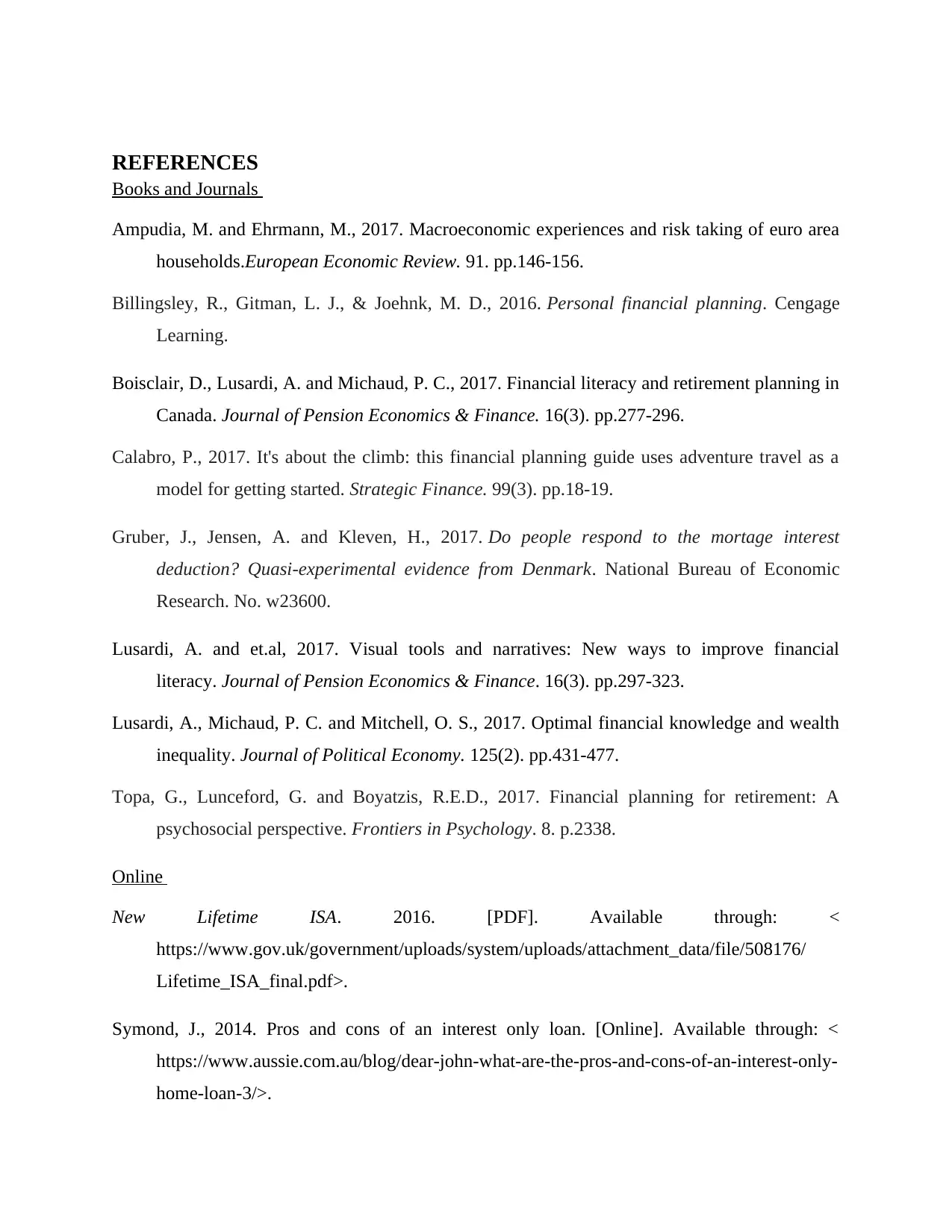
REFERENCES
Books and Journals
Ampudia, M. and Ehrmann, M., 2017. Macroeconomic experiences and risk taking of euro area
households.European Economic Review. 91. pp.146-156.
Billingsley, R., Gitman, L. J., & Joehnk, M. D., 2016. Personal financial planning. Cengage
Learning.
Boisclair, D., Lusardi, A. and Michaud, P. C., 2017. Financial literacy and retirement planning in
Canada. Journal of Pension Economics & Finance. 16(3). pp.277-296.
Calabro, P., 2017. It's about the climb: this financial planning guide uses adventure travel as a
model for getting started. Strategic Finance. 99(3). pp.18-19.
Gruber, J., Jensen, A. and Kleven, H., 2017. Do people respond to the mortage interest
deduction? Quasi-experimental evidence from Denmark. National Bureau of Economic
Research. No. w23600.
Lusardi, A. and et.al, 2017. Visual tools and narratives: New ways to improve financial
literacy. Journal of Pension Economics & Finance. 16(3). pp.297-323.
Lusardi, A., Michaud, P. C. and Mitchell, O. S., 2017. Optimal financial knowledge and wealth
inequality. Journal of Political Economy. 125(2). pp.431-477.
Topa, G., Lunceford, G. and Boyatzis, R.E.D., 2017. Financial planning for retirement: A
psychosocial perspective. Frontiers in Psychology. 8. p.2338.
Online
New Lifetime ISA. 2016. [PDF]. Available through: <
https://www.gov.uk/government/uploads/system/uploads/attachment_data/file/508176/
Lifetime_ISA_final.pdf>.
Symond, J., 2014. Pros and cons of an interest only loan. [Online]. Available through: <
https://www.aussie.com.au/blog/dear-john-what-are-the-pros-and-cons-of-an-interest-only-
home-loan-3/>.
Books and Journals
Ampudia, M. and Ehrmann, M., 2017. Macroeconomic experiences and risk taking of euro area
households.European Economic Review. 91. pp.146-156.
Billingsley, R., Gitman, L. J., & Joehnk, M. D., 2016. Personal financial planning. Cengage
Learning.
Boisclair, D., Lusardi, A. and Michaud, P. C., 2017. Financial literacy and retirement planning in
Canada. Journal of Pension Economics & Finance. 16(3). pp.277-296.
Calabro, P., 2017. It's about the climb: this financial planning guide uses adventure travel as a
model for getting started. Strategic Finance. 99(3). pp.18-19.
Gruber, J., Jensen, A. and Kleven, H., 2017. Do people respond to the mortage interest
deduction? Quasi-experimental evidence from Denmark. National Bureau of Economic
Research. No. w23600.
Lusardi, A. and et.al, 2017. Visual tools and narratives: New ways to improve financial
literacy. Journal of Pension Economics & Finance. 16(3). pp.297-323.
Lusardi, A., Michaud, P. C. and Mitchell, O. S., 2017. Optimal financial knowledge and wealth
inequality. Journal of Political Economy. 125(2). pp.431-477.
Topa, G., Lunceford, G. and Boyatzis, R.E.D., 2017. Financial planning for retirement: A
psychosocial perspective. Frontiers in Psychology. 8. p.2338.
Online
New Lifetime ISA. 2016. [PDF]. Available through: <
https://www.gov.uk/government/uploads/system/uploads/attachment_data/file/508176/
Lifetime_ISA_final.pdf>.
Symond, J., 2014. Pros and cons of an interest only loan. [Online]. Available through: <
https://www.aussie.com.au/blog/dear-john-what-are-the-pros-and-cons-of-an-interest-only-
home-loan-3/>.

⊘ This is a preview!⊘
Do you want full access?
Subscribe today to unlock all pages.

Trusted by 1+ million students worldwide
1 out of 12
Your All-in-One AI-Powered Toolkit for Academic Success.
+13062052269
info@desklib.com
Available 24*7 on WhatsApp / Email
![[object Object]](/_next/static/media/star-bottom.7253800d.svg)
Unlock your academic potential
Copyright © 2020–2025 A2Z Services. All Rights Reserved. Developed and managed by ZUCOL.

